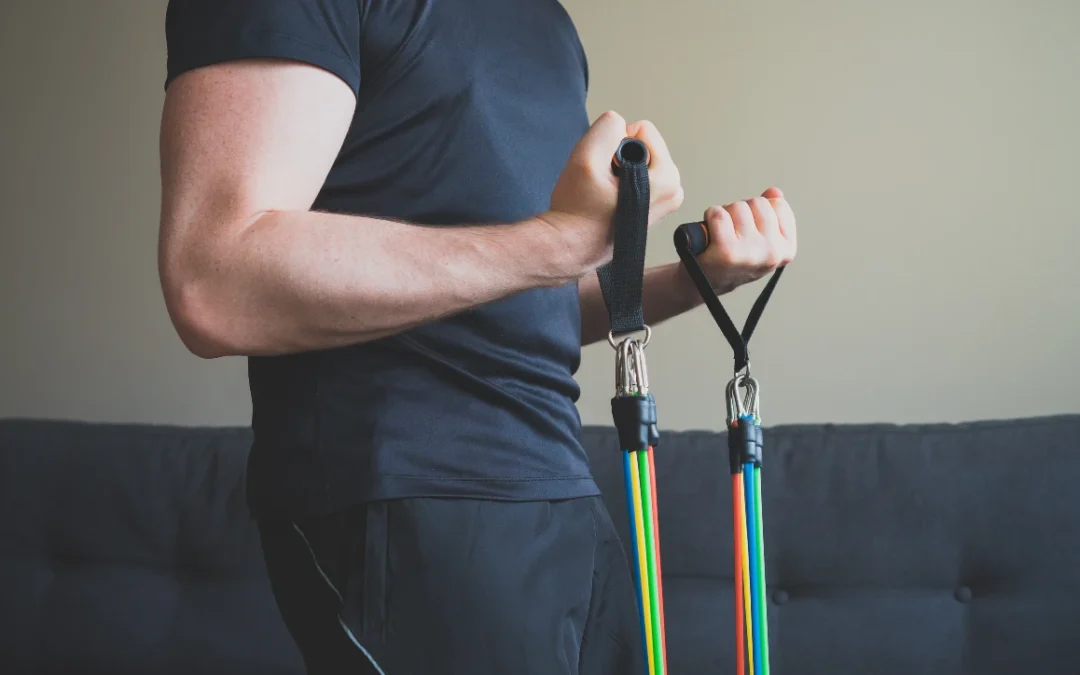Resistance training has long been a go-to for people who want to improve their muscle mass, reduce body fat, and create the aesthetic and shape they aspire to. This powerhouse of fitness and functional movement is suited to everybody and is recommended by almost every national health body.
Importantly, there are distinctions between pure strength training and resistance training, although both rely on similar basic principles. Strength training increases your muscle mass by working with weight machines or free weights, increasing the weight or repetitions to help grow your muscles over time.
As a flexible and adaptable type of exercise programme, resistance training doesn’t necessarily mean lifting big weights. Instead, it’s all about pushing, moving or pulling against resistance, which could be provided by your own body weight or a resistance band, as well as a set of weights or a machine.
What Are the Benefits of Resistance Training?
This type of movement can help to reduce the natural muscle loss that we all experience as we age. Stronger muscles and joints can reduce the likelihood of an injury or make it easier to recover, supporting good balance and flexibility.
Other advantages of adding resistance training to your exercise regime include:
- Better posture and a lower risk of developing issues linked to bone density, such as osteoporosis.
- Improved mental health, where many people find that resistance training boosts their mood and sense of self-confidence and can help to retain a positive body image.
- Increased ability to get a good night’s sleep; some practitioners recommend resistance training to help lower the impacts of sleep disorders like insomnia.
Over time, regular resistance training can aid with fat loss if that is one of your goals, support greater stamina, relieve or help with the management of conditions such as cardiovascular disease and diabetes, and overall mean you can perform everyday tasks, like climbing steps or carrying shopping bags, without putting yourself at risk of injury.
Like most types of fitness training and exercises, the right resistance workouts may depend on your current fitness, mobility and age, the frequency with which you plan to exercise, and whether there are any specific muscle groups you’d like to target.
However, building in key exercises and movements, including planks, push-ups, and squats, can be a great addition to your training routine.
Various Types of Resistance Training Routines
I’ve mentioned that there are several ways to create resistance. This can be anything that challenges your muscles or provides a force to work against. This matters because resistance training truly is accessible to all, with options including:
- Weight machines, which usually have either hydraulics or weights, which you can select by placing a pin or turning a dial to the required level of resistance.
- Resistance bands, which look like large rubber bands, and can be looped around a fixed anchor or between two points, such as your ankles.
- Body weight offers the resistance you need to perform chin-ups, push-ups, or squats. Body weight resistance is also a great target to work towards if you’re new to training.
- Free weights, such as dumbbells, kettlebells, or barbells, are common exercise tools available in various weights and sizes.
The principles are that by adding resistance, your muscles work harder to complete a movement. It is important to pick a suitable level of resistance or weight that is challenging but doesn’t make it impossible to finish the exercise without the right form.
Incorporating rest days and recovery into a resistance training routine is equally essential since your muscles need sufficient time to repair before you target the same muscle group. This is why many avid gym-goers split their workout schedule, such as having an ‘arm day’ followed by a ‘leg day’ – this is purely to provide recovery for each muscle group.
Popular Resistance Training Exercises to Try
While there are countless resistance exercises you may want to perform, much may depend on your fitness aspirations, the kit and equipment you have available, and whether you’re working with an experienced personal trainer who can guide you throughout.
Below, I’ve summarised three of the most performed resistance exercises to explain why they may be beneficial, with some tips about how you can vary the movement to suit your ability.
Squats
Many people add squats to their workout routines since they can work on several large muscle groups all at once; this is called a compound movement.
When you perform a squat, whether body weight or with an added weight or band, you’re working your glutes, quads, abs, back muscles, and calves simultaneously. This movement also challenges balance, core strength, and coordination.
Squats are functional and have endless variations. Options include squatting to a bench or chair, performing wall squats to add support, or using weighted squat machines like a Smith machine or a free-weight squat rack in a gym.
Deadlifts
Deadlifts help target the glutes, specifically the gluteus maximus, the largest muscle in the body. Strong glutes help with almost every daily activity, from walking and running to lifting and climbing stairs, keeping our posture strong and our knees stable.
While form remains key, deadlifts can be used at all levels to focus resistance on your hamstrings and glutes, beginning with very light weights or as unweighted or single-leg deadlifts to improve balance and coordination.
More advanced forms of deadlifts can be performed with any weighted object or with barbells and dumbbells as you progress.
Planks or Bridges
A plank, in which you hold your body stable and rest on your hands or elbows and feet or knees, is often overlooked in favour of other core exercises like crunches. However, it is actually a powerful resistance exercise using your own weight.
Adding planks to your workouts can help prevent issues with misalignments in your spine, improve muscle function in your core, and support every other resistance exercise you might perform, giving you the stability to use the muscles in your arms and legs.
Like any resistance exercise, you can adjust the movement according to your needs. For example, you could press against a wall, bench, or seat, then move to your knees and feet while building strength and balance through your core.
All of these resistance movements and the many other exercises or workouts you could include within a resistance training routine offer amazing benefits, whether you’d like to start resistance training to improve your overall fitness, strength, and muscle mass or are keen to get to a healthy weight and support your long-term cardiovascular health.
Don’t hesitate to get in touch with Certified Personal Trainer, Reubizzle, for further guidance and fitness advice.


Recent Comments